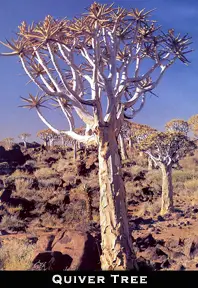 Quiver Trees (Aloe dichotoma), are also known as kokerboom, and are a species of aloe indigenous to South Africa, specifically in the Northern Cape region, and Namibia. They are referred to locally as “quiver trees” as the branches and bark are used by Kalahari San Bushmen to make quivers for their arrows. Known as Choje to the indigenous San people, the quiver tree gets its name from the San practice of hollowing out the tubular branches of Aloe dichotoma to form quivers for their arrows.
Quiver Trees (Aloe dichotoma), are also known as kokerboom, and are a species of aloe indigenous to South Africa, specifically in the Northern Cape region, and Namibia. They are referred to locally as “quiver trees” as the branches and bark are used by Kalahari San Bushmen to make quivers for their arrows. Known as Choje to the indigenous San people, the quiver tree gets its name from the San practice of hollowing out the tubular branches of Aloe dichotoma to form quivers for their arrows.
JOHANNESBURG – A famed desert tree used for generations by Africa’s bushmen to make quivers for their arrows is threatened by global warming.
With a stocky trunk topped by a tangle of forked branches, this tree has iconic status in Namibia, where its blue-green crown vividly stands out against a parched landscape.
“They are in the early stage of a poleward (southward) range shift,” Wendy Foden, a researcher at the South African National Biodiversity Institute, told a conference on climate change science in Johannesburg.
A shift towards the poles and away from the equator is precisely what one would expect as a response to warming conditions, Foden said. She said observations at over 50 sites throughout the trees’ range in Namibia and South Africa highlighted two disturbing trends which could clearly be linked to climate change.
The first was that with populations found on slopes, mortality was much higher at lower elevations than at higher ones — that is, where it would be warmer on a slope. She also found higher mortality rates in the north of its range, towards the equator, than those found in the south. Historical data from weather stations within the trees’ range also showed rising temperatures over the past few decades.
“If there is no expansion in the quiver trees’ range, then models forecast a 76 percent reduction in its population over the next 100 years, and even with dispersal its numbers could be down over 30 percent over the next century,” she said.
Wendy Foden also said the quiver trees’ situation highlighted the fact that climate change was having an impact on desert ecosystems, regions where many people assume the affects should be minimal as they are already hot and dry.
Dr Richard Pearson of the American Museum of Natural History told the conference that a species had three choices when confronted with climate change: die, adapt or migrate.
For the quiver tree, any migration it made would have to come about as a result of seed dispersal via the wind or from droppings from birds or other animals that digested them. That may help the species but not individuals, some of which are over 150 years old. “If you’re a plant, quite literally you are stuck,” Foden said. Story by Ed Stoddard, From Reuters News.
A group of scientists from the South African National Biodiversity Institute found quiver trees located in hotter northern parts of the country were struggling to survive in the drought conditions the area was experiencing. They believe, a 2C (3.6F) increase in temperature may be too much for many plants species to survive unless they are able to migrate to cooler areas, a team of scientists says. Guy Midgley, was one of the scientists involved in the study and he said, “We’re asking sedentary organisms, which have achieved an equilibrium with the climate for thousands of years, to suddenly become able to move – that’s a tough ask.”
It is the speed at which the Earth is warming that will see many species become extinct, they simply do not have enough time to adapt, or to introduce themselves to other niches.
|
Other Species Impacted Upon by Climate Change
Mountain Pine Beetle Harlequin Frog |
